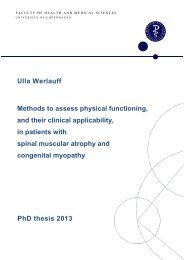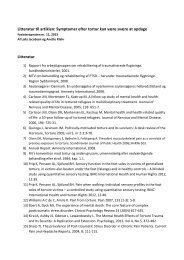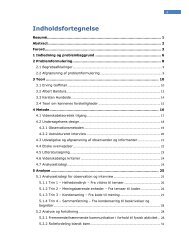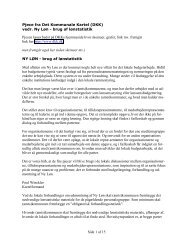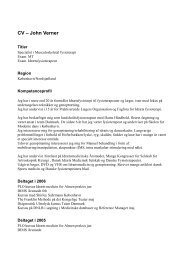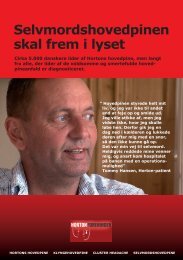Bilag 12 - Danske Fysioterapeuter
Bilag 12 - Danske Fysioterapeuter
Bilag 12 - Danske Fysioterapeuter
You also want an ePaper? Increase the reach of your titles
YUMPU automatically turns print PDFs into web optimized ePapers that Google loves.
Abstract<br />
Background: Vulvodynia is a chronic pain condition of the vulva with an unknown<br />
origin, which has only come in the public spotlight in recent decades. There has been a<br />
gradual increase in patients with vulvodynia that are referred to physiotherapy treatment<br />
because of secondary tension in pelvic floor arising from the pain condition. The<br />
research and literature about the physiotherapy treatment specifically for patients with<br />
vulvodynia is still deficient. This prompted us to speculate what is contained in the<br />
physiotherapy treatment and what it is based upon.<br />
Objective: The project aims to examine the methods used in physiotherapy for patients<br />
with vulvodynia in Denmark, and what factors influence the physiotherapy intervention.<br />
Method: Triangular study with a quantitative survey with 67 respondents and a<br />
qualitative study in the form of four semi-structured interviews. The interviewees are<br />
physiotherapists who work in the gynecological/obstetric field. The questionnaire uses<br />
descriptive statistics producing a series of graphs. The interviews are analysed according<br />
to Malterud’s systematic text condensation.<br />
Results:<br />
Questionnaire: Over 80% of the surveyed physiotherapists use relaxation, pelvic floor<br />
exercises, body awareness, stretching exercises, vaginal examination and breathing<br />
exercises as treatment for these patients. There are, in addition, a wide range of other<br />
therapies used in varying degrees.<br />
Interviews: The basis for intervention is mainly based on clinical experiences and shared<br />
experiences of colleagues. The type of treatment is based upon the individual patient's<br />
welfare, reactions and needs, as well as the physiotherapist's individual perceptions. In<br />
general the physiotherapists questioned would like to see more courses, more literature<br />
and better interdisciplinary collaboration, especially between doctors, psychologists and<br />
sexologists.<br />
Conclusions: Overall, there are many different methods of treatment used in such a<br />
narrow issue. The treatment is primarily focused upon the "best practice" for the<br />
individual patient, and it affects the physiotherapy intervention, where interdisciplinary<br />
cooperation is not optimal.



